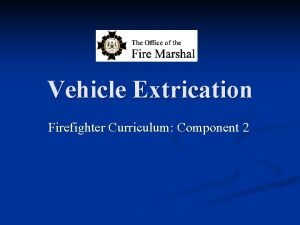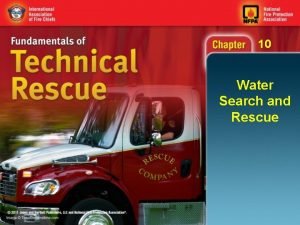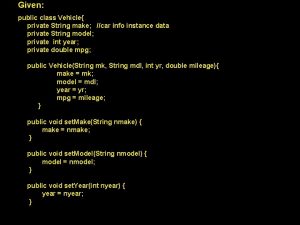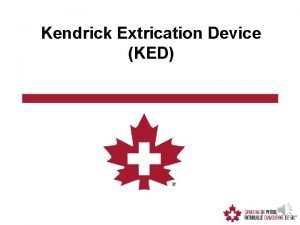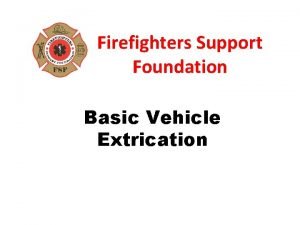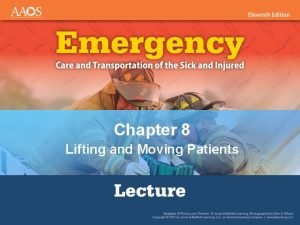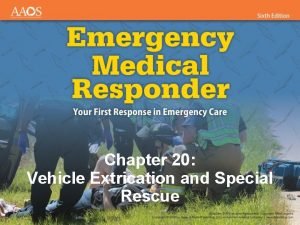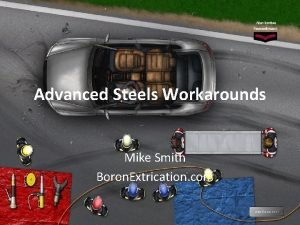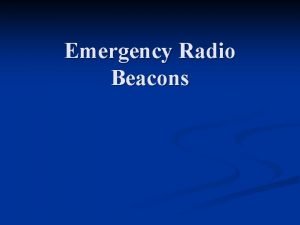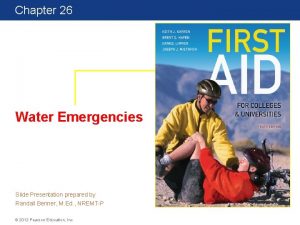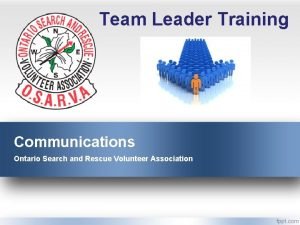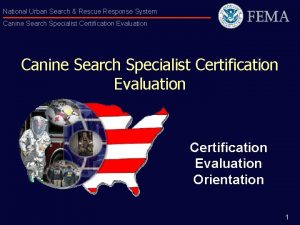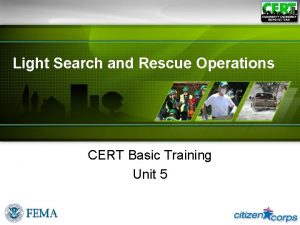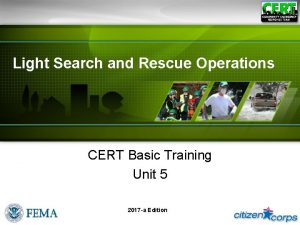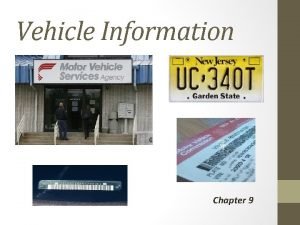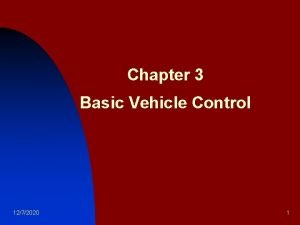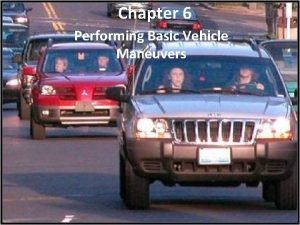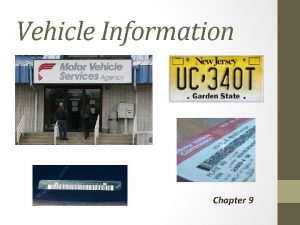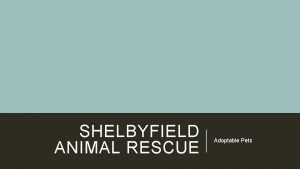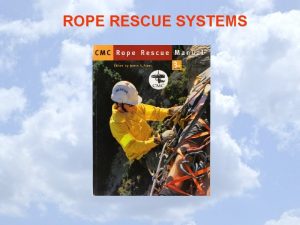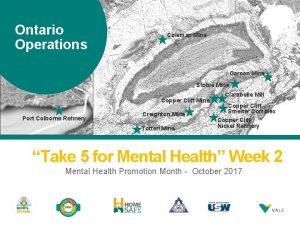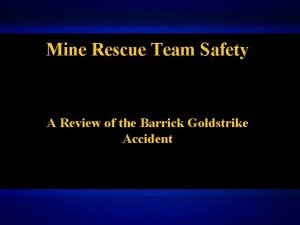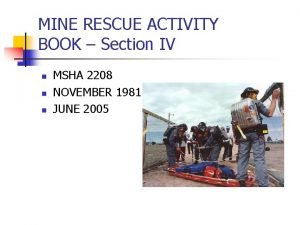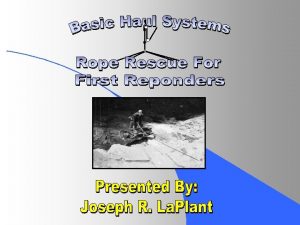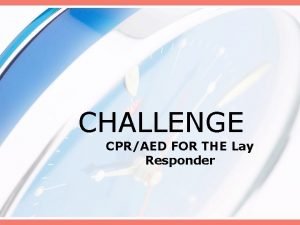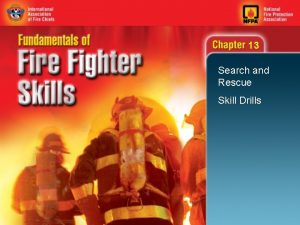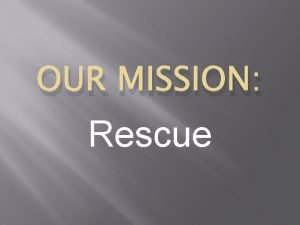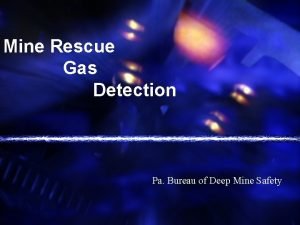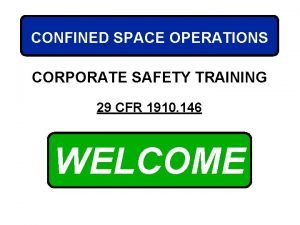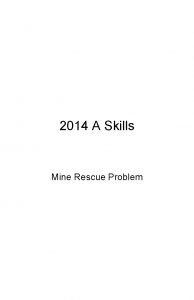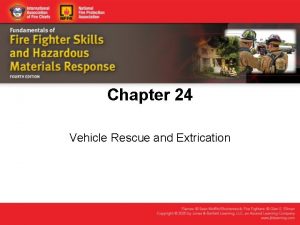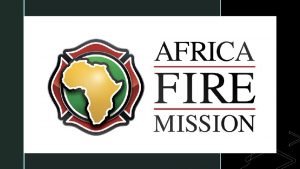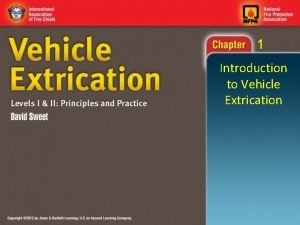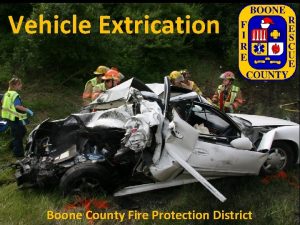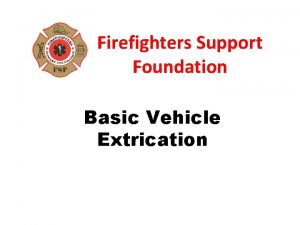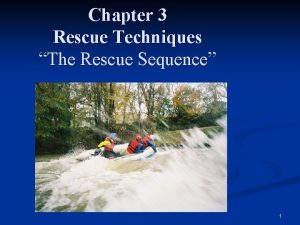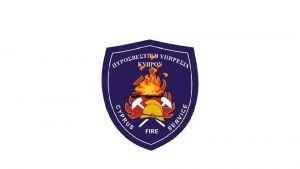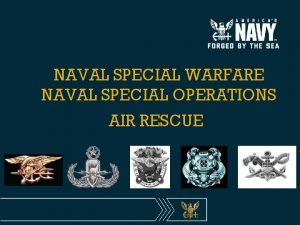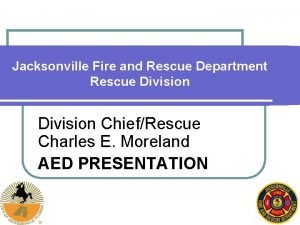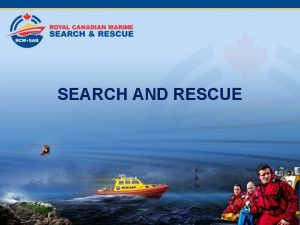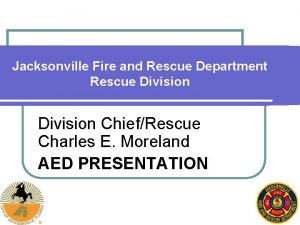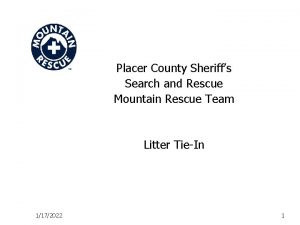Chapter 37 Vehicle Extrication and Special Rescue Introduction



































































- Slides: 67

Chapter 37 Vehicle Extrication and Special Rescue

Introduction • You will usually not be responsible for rescue and extrication. – Rescue involves many different processes and environments. – Requires training beyond the EMT level – This chapter teaches basic extrication concepts.

Safety (1 of 2) • Extrication requires mental and physical preparation. – Consider the safety of yourself and team. – Safety begins with the proper mind-set and personal protective gear. • Equipment and gear should be appropriate to anticipated hazards.

Safety (2 of 2) • Protective gear may include: – Turnout gear – Helmets – Hearing protection – Fire extinguisher – Blood- and fluidimpermeable gloves – Leather gloves over disposable gloves

Vehicle Safety Systems (1 of 2) • Can become hazards after a collision – Shock-absorbing bumpers may be “loaded” and can release and injure you. – Manufacturers are required to install air bags in all new cars.

Vehicle Safety Systems (2 of 2) • Air bags fill with a nonharmful gas on impact and quickly deflate. – Located in the steering wheel and passenger dash – Should be deployed and deflated by the time you arrive – Use eye protection to protect your eyes from the cornstarch or talc in air bags.

Fundamentals of Extrication (1 of 3) • Your primary concern is safety. • Your primary roles are to: – Provide emergency medical care. – Prevent further injury to the patient. • You may provide care as extrication goes on around you.

Fundamentals of Extrication (2 of 3) • Extrication is the removal from entrapment or a dangerous situation or position. – Entrapment is a term used when a person is caught within a closed area with no way out or has a limb or other body part trapped.

Fundamentals of Extrication (3 of 3)

Preparation • Preparing for an incident requiring extrication involves training. – Various types of rescue situations • Rescue personnel must routinely check extrication tools and the response vehicle. – Reduces the possibility of equipment failure at an emergency scene

En Route to the Scene • Procedures and safety precautions similar to those in the phases of an ambulance call are used when responding to a rescue call.

Arrival and Scene Size-up (1 of 9) • Position the unit at a safe location. – Activate emergency lights. – At a hazardous materials incident, park uphill and upwind from the hazard. • Make sure the scene is properly marked and protected. – Ensure that the road is closed or traffic is diverted.

Arrival and Scene Size-up (2 of 9) • Look for passing cars before exiting your vehicle. • Size-up is the ongoing process of information gathering and scene evaluation. – Pay attention to downed electrical lines, leaking fluids, fire, and broken glass. – Identify additional resources needed.

Arrival and Scene Size-up (3 of 9) • Situational awareness is the ability to recognize possible issues and act proactively to avoid a negative impact. • During a 360° walk-around, look for: – Mechanism of injury – Downed electrical lines – Leaking fuels or fluids

Arrival and Scene Size-up (4 of 9) • Look for (cont’d): – Smoke or fire – Broken glass – Trapped or ejected patients • Evaluate the need for additional resources, such as: – Extrication equipment

Arrival and Scene Size-up (5 of 9) • Additional resources (cont’d) – Fire suppression – Law enforcement – Haz. Mat units – Utility companies – Advanced life support units – Aeromedical transport

Arrival and Scene Size-up (6 of 9) • Other potential hazards – Look for spilled fuel and other flammables – Electrical short or damaged battery – Rain, sleet, snow – Crashes that occur on hills – Violence

Arrival and Scene Size-up (7 of 9) • Coordinate your efforts with rescue teams and law enforcement. – Communicate with the rescue team. – Start talking to the rescue team leader as soon as you arrive. – You become a member of the rescue team.

Arrival and Scene Size-up (8 of 9) • The rescue team is responsible for: – Securing and stabilizing the vehicle – Providing safe entrance and access to the patients – Extricating any patients – Ensuring that patients are properly protected during extrication – Providing adequate room during removal

Arrival and Scene Size-up (9 of 9) • EMS personnel are responsible for: – Assessing and providing medical care – Triaging and assigning priority to patients – Packaging patients – Providing additional assessment and care as needed once patients are removed – Providing transport to the ED

Hazard Control (1 of 7) • Law enforcement personnel are responsible for: – Traffic control and direction – Maintaining order at the scene – Investigating the crash or crime scene – Keeping bystanders out of the way

Hazard Control (2 of 7) • Fire fighters are responsible for: – Extinguishing any fire – Preventing additional ignition Source: © Mark C. Ide – Ensuring scene safety – Removing spilled fuel

Hazard Control (3 of 7) • Downed electrical lines are a common hazard at vehicle crash scenes. – Never attempt to move them. – Instruct the patient to remain in the vehicle until power is removed. – Remain in the safe zone, outside of the danger zone (hot zone).

Hazard Control (4 of 7) • A hot zone is an area where individuals can be exposed to: – Sharp metal edges – Broken glass – Toxic substances – Lethal rays – Ignition/explosion of hazardous materials

Hazard Control (5 of 7)

Hazard Control (6 of 7) • Bystanders can become hazards. – The rescue team will set up an off-limits danger zone. • The vehicle can also be a hazard. – Automobile on side or roof can be a danger – Ensure that the car is in park with the parking brake on and the ignition turned off.

Hazard Control (7 of 7) • Alternative fuel vehicles – Powered by electricity and electricity/ gasoline hybrids, or fuels such as propane, natural gas, methanol, or hydrogen – Disconnect the battery in all cases. – Batteries may be in the trunk or under the seats. – May be more than one battery

Support Operations • Support operations include: – Lighting the scene – Establishing tool and equipment staging areas – Marking helicopter landing zones • Fire and rescue personnel will work together on these functions.

Gaining Access (1 of 9) • Critical phase of extrication – Make sure that the vehicle is stable and hazards are controlled. – Check with the rescue leader and enter only after these conditions are met. • Exact way to gain access depends on the situation

Gaining Access (2 of 9) Source: © Mark C. Ide

Gaining Access (3 of 9) • To determine the exact location and position of the patient, consider: – Is the patient in a vehicle or in some other structure? – Is the vehicle or structure damaged? – What hazards exist that pose a risk? – In what position is the vehicle? On what type of surface? Is it apt to roll or tip?

Gaining Access (4 of 9) • As patients’ conditions change, you may have to change your course of action. • Rapid vehicle extrication may be needed to quickly remove a patient who needs cardiopulmonary resuscitation. – CPR is not effective if the patient is sitting up or lying on a soft car seat. – Use rapid extrication only as a last resort.

Gaining Access (5 of 9) • Keep the patient safe. – Talk to the patient and explain your steps. – EMS personnel should wear proper protective gear. – A heavy, nonflammable blanket can protect from flying glass or other objects. – Keep heat, noise, and force to a minimum.

Gaining Access (6 of 9) Source: © Keith D. Cullom

Gaining Access (7 of 9) • Simple access – Trying to access the patient as quickly and simply as possible without using tools or breaking glass – Cars are built for easy entry and exit. – Use all door handles or roll down the windows before using other methods. – The rescue team should provide access.

Gaining Access (8 of 9) • Complex access – Requires special tools, such as hand, pneumatic, and hydraulic devices – Requires special training – Includes breaking windows or other forcible means of entry

Gaining Access (9 of 9) Source: © Keith D. Cullom

Emergency Care (1 of 2) • Perform a primary assessment and provide care before further extrication: – Provide manual stabilization to the spine. – Open the airway. – Provide high-flow oxygen. – Assist or provide for adequate ventilation. – Control any significant external bleeding. – Treat all critical injuries.

Emergency Care (2 of 2) • Good communication and clear leadership are essential to proper emergency care. – One member must clearly be in charge. – A lack of identifiable leadership hinders rescue efforts.

Removal of the Patient (1 of 4) • Coordinate with rescue personnel to determine the best removal route. – Multistep process that requires many rescuers, equipment, and time

Removal of the Patient (2 of 4)

Removal of the Patient (3 of 4) • You should participate in the preparation for patient removal. – Determine the urgency of extrication. – Determine the position to best protect the patient. – Determine how you will move the patient to the backboard and then the stretcher. – Determine the extent of the injuries.

Removal of the Patient (4 of 4) • Your input is essential to the rescue team to ensure that the patient’s injuries are considered. – Impractical to apply extremity splints within the vehicle • Often you will be placed in a vehicle alongside the patient. – Be sure to wear proper PPE.

Transfer of the Patient (1 of 3) • Perform a complete primary assessment once the patient is free. – Make certain that the spine is manually stabilized. – Apply a cervical collar if not already done. • Move the patient in a series of smooth, slow, controlled steps with designated stops.

Transfer of the Patient (2 of 3) • One person should be in charge. – Choose a path that requires the least manipulation. – Make sure there are sufficient personnel. – Move the patient as a unit. – Do not move the immobilization device.

Transfer of the Patient (3 of 3) Source: © Keith D. Cullom

Termination • Termination involves returning emergency units to service. – All equipment used on the scene must be checked. – Check and clean the ambulance, replacing used supplies. – Complete all necessary reports.

Specialized Rescue Situations (1 of 3) • Sometimes a patient can only be reached by special teams. • Specialized team skills include: – Cave rescue – Confined space rescue – Cross-field and trail rescue (park rangers) – Dive rescue

Specialized Rescue Situations (2 of 3) • Specialized team skills include (cont’d): – Lost person search and rescue – Mine rescue – Mountain-, rock-, and ice-climbing rescue – Ski slope and cross-country or trail snow rescue – Structural collapse rescue

Specialized Rescue Situations (3 of 3) • Specialized team skills include (cont’d): – Special weapons and tactics (SWAT) team – Technical rope rescue (low- and high-angle rescue) – Trench rescue – Water and small craft rescue – White-water rescue

Technical Rescue Situations (1 of 3) • May contain hidden dangers – Personnel need special technical skills. – Not safe to include untrained personnel • A rescue group is trained and on call for certain types of technical rescues. – Made up of individuals from one or more departments – Many members are also trained as EMTs.

Technical Rescue Situations (2 of 3) • Check with the incident commander to see if the technical rescue group has been summoned. – The incident commander has overall command of the scene in the field. – If no incident commander is present, follow local guidelines.

Technical Rescue Situations (3 of 3) • If the rescue is a long distance from the ambulance, take a long backboard and/or a basket stretcher. – Take all carry-in kits and other equipment. – Set up the equipment at a stable location. – Perform a primary assessment as soon as the rescue team brings the patient to you. – Packaging and carrying requires a joint effort.

Lost Person Search and Rescue (1 of 3) • An ambulance is usually summoned to the command post when a person is lost outdoors and a search effort is initiated. – Your job is to stand by at the command post until the person or persons are found. – Once you are briefed on the situation, isolate and prepare the equipment you may need.

Lost Person Search and Rescue (2 of 3) • You may be asked to stay with the family of the lost individual. – Gather medical history and communicate to those in charge. – Only the incident commander should communicate any news or progress to the family. – Set your radio at a discreet volume.

Lost Person Search and Rescue (3 of 3) • Once the lost person is found, you will be instructed where and when to meet. – Ensure that the equipment is evenly distributed among providers. – Ensure a pace is maintained that all can keep up with. – You may need to relocate the ambulance or use an all-terrain vehicle.

Trench Rescue (1 of 4) • Many cave-ins and trench collapses have poor outcomes for victims. – Collapses usually involve large areas of falling dirt that weigh approximately 100 lb per cubic foot. – Victims cannot fully expand their lungs and may become hypoxic.

Trench Rescue (2 of 4) • Risk of secondary collapse is a concern. – Safety measures can reduce the potential for injury. • Park response vehicles at least 500′ from the scene. – All vehicles should be turned off. – Road traffic should be diverted from the 500′ area.

Trench Rescue (3 of 4) • Other hazards include downed electrical wires and broken glass or water lines. – Construction equipment may be unstable and could fall into the cave-in or trench. • Witnesses to the incident should be identified. – May be valuable in providing information

Trench Rescue (4 of 4) • Nontrapped individuals should be assisted from the area. • Do not enter a trench deeper than 4′ without proper shoring in place. • During extrication, medical personnel trained in cave-in and trench collapse will provide most medical care. – Be prepared to receive patients after.

Tactical Emergency Medical Support (1 of 3) • Law enforcement personnel usually ensure scene safety. – Sometimes a special weapons and tactics (SWAT) team is needed to secure an area. • Hostage incidents • Barricaded subjects • Snipers

Tactical Emergency Medical Support (2 of 3) • When called to the scene, determine the location of the command post and report to the incident commander. – Lights and siren should be turned off. – The command post is usually located in the safe zone. – Do not stray from the safe zone.

Tactical Emergency Medical Support (3 of 3) • Organization is key. – Have the incident commander identify the specific location of the incident. – Plan a location to meet up with the SWAT team if an injury occurs. – Designate helicopter landing zones. – Identify the quickest route to the closest hospital, burn center, or trauma center.

Structure Fires (1 of 4) • Generally, an ambulance is dispatched with the fire department apparatus. – A fire in a house, apartment building, office, school, plant, warehouse, or other building is considered a structure fire. – Determine if an alternate route is needed because of the fire.

Structure Fires (2 of 4) • Ask the incident commander where the ambulance should be staged. – Far enough away from the fire to be safe – Cannot block or hinder other arriving equipment – Cannot be blocked in – Should be close enough to be visible so patients can be brought to it easily

Structure Fires (3 of 4) • Search and rescue in a burning building requires special training and equipment. – Performed by teams of fire fighters in full turnout gear and SCBA – They bring patients out of the burning building to the area where the ambulance is. – You should always remain with the ambulance unless otherwise instructed.

Structure Fires (4 of 4) • Sometimes a scene may be further complicated by hazardous materials. – Any substance that is toxic, poisonous, radioactive, flammable, or explosive and can cause injury or death with exposure – Hazardous materials pose a threat to you and to others at the scene, as well as a much larger area and population.
 Vehicle anatomy for extrication
Vehicle anatomy for extrication Vehicle extrication diagram
Vehicle extrication diagram Vehicle extrication lesson plan
Vehicle extrication lesson plan Reach throw wade row swim tow
Reach throw wade row swim tow Cosmic superclass
Cosmic superclass Ked order of straps
Ked order of straps What is the purpose of a ked?
What is the purpose of a ked? Extrication is defined as
Extrication is defined as Nader pin
Nader pin Direct ground lift emt
Direct ground lift emt Phases of extrication
Phases of extrication As an emr, your two primary extrication goals include:
As an emr, your two primary extrication goals include: Boron extrication
Boron extrication Moving and lifting of the patient
Moving and lifting of the patient Marcus to the rescue translation
Marcus to the rescue translation Chapter 4 performing basic maneuvers answer key
Chapter 4 performing basic maneuvers answer key Chapter 17 owning and maintaining a car
Chapter 17 owning and maintaining a car Analyzing insurance coverage worksheet chapter 16
Analyzing insurance coverage worksheet chapter 16 Chapter 9 vehicle maintenance fluid service and recycling
Chapter 9 vehicle maintenance fluid service and recycling Search and rescue radar transponder
Search and rescue radar transponder Search and rescue aircraft signals
Search and rescue aircraft signals Hip and shoulder support water rescue
Hip and shoulder support water rescue Ontario search and rescue volunteer association
Ontario search and rescue volunteer association Urban search and rescue markings
Urban search and rescue markings Usar search markings
Usar search markings Image search
Image search Pierce county search and rescue
Pierce county search and rescue Chapter 9 vehicle information
Chapter 9 vehicle information Performing basic vehicle maneuvers
Performing basic vehicle maneuvers Chapter 3 basic vehicle operation
Chapter 3 basic vehicle operation Chapter 3 basic vehicle control
Chapter 3 basic vehicle control A turnabout is a maneuver for *
A turnabout is a maneuver for * 5 types of turnabouts
5 types of turnabouts Chapter 9 vehicle information
Chapter 9 vehicle information Exceptional learners: an introduction to special education
Exceptional learners: an introduction to special education Introduction of exceptional child
Introduction of exceptional child Exceptional children an introduction to special education
Exceptional children an introduction to special education Chapter 10 somatic and special senses
Chapter 10 somatic and special senses Medical terminology chapter 11 learning exercises answers
Medical terminology chapter 11 learning exercises answers Anatomy and physiology chapter 8 special senses
Anatomy and physiology chapter 8 special senses The general and special senses chapter 9
The general and special senses chapter 9 Boulder food rescue
Boulder food rescue Shelbyfield
Shelbyfield Radium release hitch
Radium release hitch Rescue swimmer course
Rescue swimmer course Rescue deck
Rescue deck Stobie mine
Stobie mine Mine rescue 19-5
Mine rescue 19-5 Mine rescue 7-19
Mine rescue 7-19 Mine rescue 13-17
Mine rescue 13-17 In what way did brian's past science lessons come in handy
In what way did brian's past science lessons come in handy Realise 3. hali
Realise 3. hali Rope rescue terminology
Rope rescue terminology Lay responder
Lay responder Mine rescue level 13-3
Mine rescue level 13-3 Umer zeeshan ijaz
Umer zeeshan ijaz Robocup maze
Robocup maze Protoplast fusion
Protoplast fusion Rescue
Rescue Deep mine rescue
Deep mine rescue A rescue plane flies at 198 km/h
A rescue plane flies at 198 km/h Confined space rescue equipment
Confined space rescue equipment Confined space rescue equipment
Confined space rescue equipment Mine rescue 9-3
Mine rescue 9-3 Confined space rescue equipment
Confined space rescue equipment Aunt flossie's hats
Aunt flossie's hats Mine rescue 19-1
Mine rescue 19-1 Makalu gau
Makalu gau

